Solovetsky Stone (Saint Petersburg)
The Solovetsky Stone is a monument in honor of victims of political repression in the Soviet Union and fighters for freedom. The monument stands in Troitskaya Square in Saint Petersburg, in the vicinity of several other buildings, directly related to political repressions in the USSR—the House of Tsarist Political Prisoners, the prison and the necropolis of the Peter and Paul Fortress, and the Bolshoy Dom. Nowadays it also serves as a central spot of all memorial events and gatherings related to actual human rights problems.
| Solovetsky Stone | |
|---|---|
| Russian: Соловецкий камень, Monument to victims of political repression in Petrograd-Leningrad | |
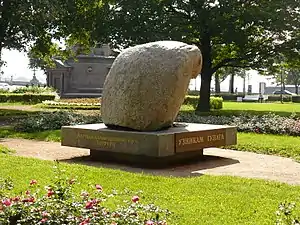 | |
| Artist | Yuly Rybakov, Yevgeny Ukhnalyov |
| Completion date | September 4, 1990: Foundation stone September 4, 2002: Solovetsky Stone |
| Medium | Granite |
| Movement | Minimalism |
| Dimensions | 225 cm × 230 cm × 235 cm (89 in × 91 in × 93 in) |
| Weight | 10,400 kg |
| Location | Saint Petersburg |
| 59.952313°N 30.326125°E | |
The monument consists of a large stone brought from the Solovetsky Islands, the location of Solovki prison camp. The camp symbolizes all of the Soviet Gulag system and the related terror. The initiative belongs to the Memorial society, the monument's design was created by artists Yuly Rybakov and Yevgeny Ukhnalyov, themselves political prisoners during Soviet times.
Construction and symbolism
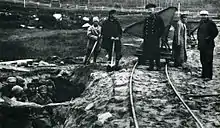
The monument comprises the Solovetsky Stone, a massive granite slab from the Solovetsky Islands in the White Sea, where the Solovki concentration camp located. This prison's name turned into a denominative in the Russia language, it became a symbol of the punitive Gulag system that in 1920s held more than 100,000 prisoners, from 1930s to 1950 the number of the incarcerated people reached 18 mln, at least 1.5 of them died.[1][2] In the aftermath, the Gulag traumatized and influenced several generations of Russians and in many aspects shaped the society and its culture.[3][4][5] The granite slab was taken from boulders near the Savvatiyev Skete of the Solovetsky Monastery, which was used as the 'political infirmary' in the 1920s. Here on December 19, 1923, the prisoners protested against the drastic treatment and were shot by guards and specially arranged firing squad.[6][7][8] This massacre is considered to be the next step in Soviet repressions, but also an important precedent of resistance.[9][NB 1] According to other sources, the stone was taken from the Sekirnaya Gora, the hill in the vicinity of the Savvatiyev Skete. The Voznesensky Skete on the Sekirnaya Gora was used as a punitive confinement and an execution yard.[10][11][12]
The Solovetsky Stone symbolizes the pre-Christian idea of continuity and hereditivity of existence, as an artifact from "that very place", keeping "the spirit of our ancestors".[13][14][NB 2] As envisioned by the authors, the stone's rough aesthetics makes it a 'backbone of personality, that survives despite the faceless evil'.[16]
The monument is designed in a minimalist style and has a non-religious, secular character. It features a crude granite slab 1.7 m (5 ft 7 in) high, mounted on square granite pedestal (0.35 m × 2.35 m × 2.3 m [1 ft 2 in × 7 ft 9 in × 7 ft 7 in]), based on concrete impost with granite foot around 0.2 m (7.9 in) high.[17][18] The edges are oriented on cardinal points. From a certain angle, the stone resembles an elephant, which in Russian ('слон', 'slon') sounds like an abbreviation of Соловецкий лагерь особого назначения, the Solovetsky camp's name.[19][20]
The monument conveys its meaning also via the text on the pedestal.[14] The words on the northern side are "Узникам ГУЛАГа" (To Gulag Prisoners), "Борцам за свободу" (To Fighters for Freedom) on the west, "Жертвам коммунистического террора" (To Victims of Communist Terror) on the east. On the southern side there are words from Anna Akhmatova's poem The Requiem: "I wish I could call everyone by the name". However, the monument doesn't name any specific names, because not all of the victims are known yet. Yuly Rybakov, one of the designers, consider the western line as the most important one because it commemorates not only the victims, but also all fighters with the repressive system.[21][19][9] The lines on the Eastern side directly announces those responsible for the terror, which is the rare case among similar monuments in Russia.[22] Historian Alexander Etkind thinks that the direct indication of communism as the reason for this catastrophe gives the monument worldwide significance.[23] The text on the Solovetsky Stone tells nothing about its background, in the authors' idea this should evoke interest in bypassers and make them curious to find more information themselves.[9]
The monument is dedicated to all "shot, arrested, exiled, banned, broken by the Communist regime, whose tombs are lost and fates are unknown". The Memorial society, which initiated and sponsored the monument's creation, described its significance: "This monument is a gift to the city for its 300 Anniversary from the former political prisoners, who treasure freedom and human dignity more than personal safety and well-being. The Solovetsky Stone in Troitskaya Square is the symbol of free social thoughts, political and civic liberties. This monument pays tribute to all the victims of purposeless terror, it commemorates our fellow citizens, who suffered from political repressions. It honors those who fought for human dignity among triumphant cruelty and didn't succumb to evil, preserving inner personal freedom and remained human in the nonhuman world. This monument shows how a personality can overcome the totalitarian regime, it rejects violence and xenophobia. We live in an unstable country, which cannot guard our rights and freedom. So let this stone serve our freedom."[24][25]
 Troitskaya Square: Solovetsky Stone, Peter and Paul Fortress and Cathedral
Troitskaya Square: Solovetsky Stone, Peter and Paul Fortress and Cathedral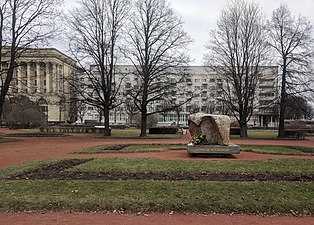 Troitskaya Square: Solovetsky Stone, House of Tsarist Political Prisoners
Troitskaya Square: Solovetsky Stone, House of Tsarist Political Prisoners Troitskaya Square: Solovetsky Stone, Museum of Political History
Troitskaya Square: Solovetsky Stone, Museum of Political History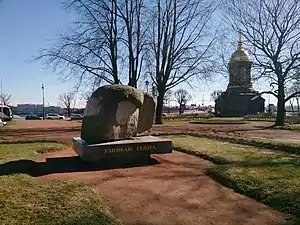 Troitskaya Square: Solovetsky Stone, Trinity Chapel
Troitskaya Square: Solovetsky Stone, Trinity Chapel
The location of the Solovetsky Stone is also significant. The Former Political Convicts Residential House (FPCRH) that stands in front of the monument was built by the Soviet government in the early 1930s. It was intended for the revolutionaries and political activists, persecuted by the State police in Imperial Russia. Ironically, many inhabitants of the FPCRH fell victims of the Great Purge in 1937–38. The Museum of Political History of Russia (St. Petersburg) buildings to the north of Troitskaya square during the revolution housed the Bolsheviks' authorities, who later headed the uprising and initiated state terror.[25] On the Field of Mars across the Neva there is a memorial necropolis, dedicated to the revolutionaries of 1917. Historian Zuzanna Bogumil considers this closeness a vivid illustration of the way, in which "the revolution devours its children".[9] Across the Neva to the east is the Bolshoy Dom, built in the 1930s headquarters of the NKVD, which now hosts its successor — the FSB.[14][NB 3] To the west, Troitskaya Square borders to the Peter and Paul Fortress, since the Tsarist era its Trubetskoy Bastion was used as a political prison. After the revolution, the Soviet government incarcerated political prisoners here,[25] and it would later become the first location of the Great Purge.[27] A mass grave was discovered at the Golovkin Bastion in 2007 and found to contain the bodies of victims of the Red Terror, perhaps even four of the Grand Dukes of Russia. In 2003 the Holy Trinity Chapel was built to the northeast of the Solovetsky Stone, marking the location of the former Old Trinity Cathedral. The Cathedral was demolished in 1933 during the antireligious campaign of the Soviet Government.[25][NB 4] Moreover, Troitskaya Square is the oldest administrative centre of St. Petersburg. Zuzanna Bogumil reminds us that Peter the Great established the city and commanded to develop it, regardless of the human losses. That is why the Solovetsky Stone emphasizes the problem of inhuman treatment of people throughout Russian history.[9]
History
20th century
Commemoration of the victims of Soviet repression was first announced in October 1961 at 22nd Congress of the Communist Party of the Soviet Union. However, when Nikita Khrushchev's program of De-Stalinisation ended in 1964, political dissidents were repressed again during the post-Khrushchev era.[28] The idea persisted among the Soviet dissidents during the 1970s.[29] In the 1980s, during the Perestroika reforms, the policy of democratization and relaxed censorship finally allowed open discussions of the previously forbidden topic of state terror.[30] At the end of the 1980s, the 'Memorial' society was established. One of its major tasks was to commemorate the victims of political repressions, at first only in Moscow, but since 1988 the St. Petersburg branch actively integrated into the society's work.[31][32][33]
In June 1989 the Leningrad branch of the Memorial society called on citizens to create the memorial in honour of the victims of political repressions. As envisioned by the initiators, the memorial should also be supported by a museum and an archive. Several locations were considered for the future monument: the Levashovo Memorial Cemetery, the Bolshoy Dom, the Kresty Prison, and Troitskaya Square (then called Revolution Square) in front of the Former Political Convicts Residential House. The society invited all citizens to join the discussion of the idea and initiated the fundraising campaign.[33]
On March 27, 1990, the Executive Committee of the Leningrad City Congress of People's Deputies announced "an open competition on the best concept, location and design offer of a monument in honour of the victims of Stalin's terror". Troitskaya Square had been chosen as the preferred location.[34] However, social activists protested and demanded commemoration of all victims of Soviet repression. As a result, on June 17, 1992, the Leningrad City Congress cancelled the competition before its start.[24][35]
Meanwhile, the society took the initiative and announced the creation of a small, temporary sign as a placeholder instead of the desired monument, which required solid investments of time and money.[9] So on September 4, 1990, on the last day of the International Conference on Human Rights and on the eve of Victims of the Red Terror Memorial Day (September 5), the square granite memorial plate was installed at the place of the future monument. The plate was crowned with a wreath made of barbed wire, the southern and northern edges were carved with a quotation from Akhmatova's poem I Wish I Could Call Everyone by Name.[19][33][36] The design was created by artist Dmitry Bogomolov.[37]
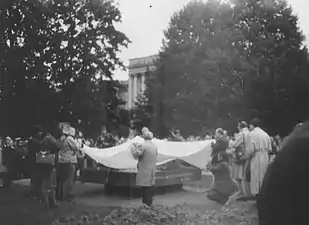 The opening ceremony
The opening ceremony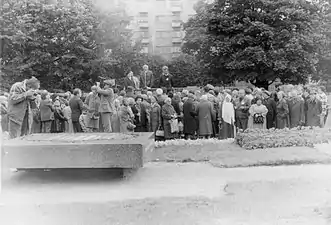 The opening ceremony
The opening ceremony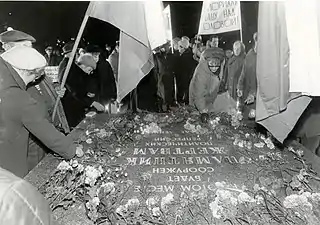 At the memorial
At the memorial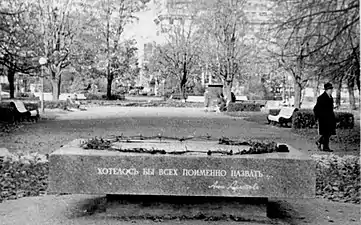 Overview
Overview
On October 1, 1990, the government initiated the second round of the project competition. This time it considered the demand to widen the monument's message to "condemn all violence and illegality, neglection of political and any other intolerance" without reference to specific historical moments.[35][38] The panel of judges was headed by two persons directly affected by the Red terror: artist Andrei Mylnikov, whose father was executed in 1918, and art expert Dmitry Likhachov, a survivor of the Solovki camp. The entry projects were displayed in the State Museum of the History of St. Petersburg in Spring 1991. On June 3, 1991, the jury discussed the offered projects. The preferred work of Dmitry Bogomolov comprised a bronze human figure, crashed and crucified between four rocks. The lettering on the rocks was a record of political repressions in Petrograd-Leningrad. However, soon the city government lost interest and the competition was cancelled.[33][39][40][41]
In 1995–1996 with the help from the Mayor of Saint Petersburg, Anatoly Sobchak, several other memorials of political repressions victims were opened in the city: the Metaphysical Sphinxes by Mihail Chemiakin in front of the Kresty Prison, and the Moloch of Totalism at the Levashovo Memorial Cemetery. Both monuments were widely criticized by former political prisoners and social activists for unclear message and depiction of evil and violence.[36][42][43] The municipal government announced in 1996 that it would build a monument based on the ideas of Edward Zaretsky,[44] a Leningrad-based sculptor and a member of local Jewish community. He founded the 'Tsayar' artistic union and created such memorials as the monument to Jews, victims of political repressions (1997) at the Levashovo Memorial Cemetery.[45][46] Memorial's co-founder Veneamin Iofe publicly criticized the city administration in 1998 for ignoring the monument during the reburial ceremony of the Romanovs, even though its route passed through Troitskaya Square.[36]
The city government stalled the initiative for more than 10 years.[11][47] Memorial's idea of a larger monument vanished after the 1998 Russian financial crisis. The same fate came upon many similar initiatives across the country.[9] In the late 1990s, the bronze wreath was stolen by vandals.[19][36][40]
21st century
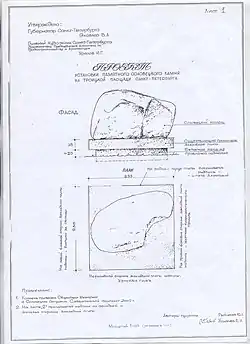
At the turn of the new millennia, the 'Memorial' society renewed the attempts to create the monument. The socio-political climate in the country wasn't suitable again as Russia's new president Vladimir Putin was an officer of the KGB. Some social activists didn't believe the administration would allow construction of the monument.[27] Veneamin Iofe decided to use the examples of Moscow and Arkhangelsk and requested permission from the authorities to install a rock from the Solovki Islands.[9][14][19] After his death in 2002 his widow Irina Flige took over.[40][47] On behalf of the Memorial she wrote a letter to the city administration, formulating the main points of the future monument: "The memory of political repressions victims is inseparable from zero tolerance to any ideological violence and political terror, so it should be clear of any signs of evil and death, of tyranny upon the human soul. The absolute political terror which followed all our Soviet history resulted in the death of people of various confessions: the Orthodox, the Moslems, the Yahudi, the Baptists, and even atheists. That is why the monument should be nonsectarian. Having regard to the above, we consider installing the granite slab from the Solovki Islands to be the best option, using the square granite memorial plate as a pedestal. The Solovki concentration camp symbolizes the Gulag in the history of our country. The Solovetsky Stone will become a decent sign to commemorate those, whom we lost to the purposeless terror".[48] In March 2001, the monument was included in the celebration programme of the 300th Anniversary of Saint Petersburg. However, it was approved without the budget funding.[11][49]
The design was created by artists Yuly Rybakov and Yevgeny Ukhnalyov (designer of the Russian coat of arms).[47] Both artists suffered political repressions during Soviet times.[19][29] The monument was financed by donations, mostly from former political prisoners and their families. Organisations such as the Memorial Society, the Civil Control, and the Union of Right Forces political party, made significant contributions.[50][22][29][47] During their special expedition on the Solovki Islands Rybakov, Ukhnalyov and Flige found the massive granite slab near the Savvatyev Skete. The transportation o the 10,400 kilograms [22,900 lb] stone to St. Petersburg was difficult but aided by local fishermen and industrial workers and the staff of the Solovki museum.[11][19][29]
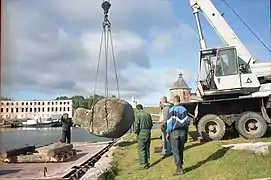 Loading the stone
Loading the stone Loading the stone. Yuly Rybakov
Loading the stone. Yuly Rybakov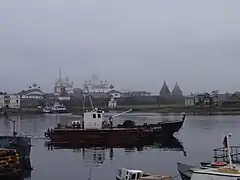 Sailing off the Solovetsky Islands
Sailing off the Solovetsky Islands Installing the monument. Yuly Rybakov, Yevgeny Ukhnalyov
Installing the monument. Yuly Rybakov, Yevgeny Ukhnalyov After the installation: Yuly Rybakov, Irina Flige, Yevgeny Ukhnalyov
After the installation: Yuly Rybakov, Irina Flige, Yevgeny Ukhnalyov
The unworked stone was transported to St. Petersburg and installed onto the pedestal, built in 1990. Three more lines were added to the edges around the pedestal, addressing victims of the repressions.[20] The monument was open on September 4, 2002, on the 12th Anniversary of the installing of the memorial plate,[19] but the official ceremony took place on October 30, on the Day of Remembrance of the Victims of Political Repressions, it coincided with the 300th Anniversary of St. Petersburg. The decree No. 2572-pa of city Governor Vladimir Yakovlev, since from October 15, 2002, made the monument city property.[20][21]
Significance

The annual mourning ceremony in memory of the victims of political repressions and the Red Terror takes place near the Solovetsky Stone on September 5. Among the annual actions there is the reading aloud of the names of victims of political repression.[40][51] The Solovetsky Stone also became a location for public meetings dedicated to the victims of political terror, memorable dates in Russia's history, anti-violence and xenophobia, and other human rights initiatives.[52] Anna Politkovskaya,[53] Natalya Estemirova,[54][55] Stanislav Markelov and Anastasia Baburova,[56] Alexei Devotchenko,[57] Natalya Gorbanevskaya,[58] Valeriya Novodvorskaya,[59] Boris Nemtsov,[60] Vladimir Bukovsky, [61] and others were commemorated here. The first Saturday of June is the Memorial Day of the Victims of the Leningrad and Petrograd prisons and takes place near the Solovetsky Stone,[62] followed in early August by gatherings on the anniversary of the beginning of the Great Purge.[63] On December 17, the day of the enactment of Stalin's punitive law, LGBT activists lay floral tributes on the pedestal of the monument. Protests take place annually on December 20 (on the Day of Secret Police Workers).[64] The meetings to support victims of the Bolotnaya Square case, the Network case and other oppressed people are also held here.[65][66]
The Solovetsky Stone has been vandalized several times: within the first months after opening it was painted with fylfots and phrases 'not enough were killed', 'slaves', etc.[67] The attacks repeated in 2003,[68] 2007, 2012,[69] and 2013.[70] In 2013 the issue of liability for the monument's condition was raised for the first time.[71] Finally Petersburg's ombudsman Alexander Shishlov demanded clarification of the monument's status.[72] In 2015 the traditional December Memorial Day was disturbed by a march of people with portraits of Adolf Hitler. City administration and the local police didn't react, and human rights activists considered the march a staged provocation from the government.[73] In 2018 the Last Address civic initiative and the Solovetsky Stone were publicly criticized by nationalist Aleksandr Mokhnatkin.[74] On October 30, 2018, city governor Alexander Beglov laid flowers at the monument.[75]
References
- Werth, Nicolas (20 January 2009). "STATE VIOLENCE IN STALIN's REGIME : OUTLINE FOR AN INVENTORY AND CLASSIFICATION" (PDF). Stanford University.
- G. Zheleznov, Vinogradov, F. Belinskii (December 14, 1926). "Letter To the Presidium of the Central Executive Committee of the All-Union Communist Party (Bolshevik)". Retrieved April 15, 2015.CS1 maint: multiple names: authors list (link)
- Applebaum 2012.
- Barnes 2011, pp. 1–2.
- Jakobson 1993, pp. 5–9.
- "Памятный знак политзаключенным, расстрелянным в Савватиевском скиту" [The Memorial to Political Prisoners, Shot at the Savvatiyev Skete on 19th of December, 1923] (in Russian). Sakharov Centre. Retrieved 2020-05-19.
- Andreeva, E. (2017-09-05). "Лагерные шрамы Соловецкого монастыря" [Solovetsky Monastery's Scars from the Past] (in Russian). TASS. Retrieved 2020-07-20.
- Melgunov 2015, p. 270.
- Bogumil, Z. (2010). "Кресты и камни: соловецкие символы в конструировании памяти о ГУЛАГе" [Crosses and Stones: the Solovetsky symbols in Gulag Memories Reconstruction] (in Russian). 'NZ' magazine. Retrieved 2020-03-16.
- Ezhelev, A. (2012). "Прокомментируем" [The Comments] (in Russian). 'Terra incognita' Almanac. Retrieved 2020-03-16.
- Rubakov, Y. (2002). "Узникам ГУЛАГа посвящается…" ['In Honour of Gulag's Victims'] (in Russian). 'Terra incognita' Almanac. Retrieved 2020-03-16.
- "Памяти узников соловецких политскитов" [In Memory of Political Prisoners of Solovetsky Sketes] (in Russian). 'Memorial' Society. 2013-08-15. Retrieved 2020-05-19.
- Etkind, A. (2011-08-09). "Памятники горечи и глупости" [Memorials of Sadness and Stupidness] (in Russian). Snob. Retrieved 2020-03-16.
- Etkind, A. (2017-02-27). "И след их вечен…" [And Their Traces Are Forever] (in Russian). 'Hefter' magazine. Retrieved 2020-03-16.
- Dorman, V. (2010). "От Соловков до Бутово: Русская Православная Церковь и память о советских репрессиях в постсоветской России" [From Solovki to Butovo: the Russian Orthodox Church and Memories of Soviet Repressions in Post-Soviet Russia]. Laboratorium (in Russian) (2): 327–347. ISSN 2076-8214.
- "Память – живая и мертвая" [Memory: Dead and Live] (in Russian). Novaya Gazeta. 2017-03-27. Retrieved 2020-03-16.
- "Недоразумение с надписями на Соловецком камне исчерпано" [The Incident with Phrases on the Solovetsky Stone is Resolved] (in Russian). St. Petersburg City Administration. 2019-07-01. Retrieved 2020-03-16.
- Sakharov Center 2019.
- "Открытие памятника жертвам коммунистического террора в Санкт-Петербурге—2002-09-04" [Monuments of Communist Terror Victims to Open in St. Petersburg] (in Russian). Voice of America. 2002-09-04. Retrieved 2020-03-16.
- Artemenko, M. (2018-10-26). ""Волга народного горя": В Петербурге почтут память жертв политических репрессий" [Volga of National grief: St. Petersburg Honours Memory of Victims of Political Repressions] (in Russian). Novaya Gazeta. Retrieved 2020-03-16.
- "Увековечение памяти жертв политических репрессий в Санкт-Петербурге: перечень памятников и мемориальных досок" [The Perpetuation of the Memory of the Victims of Political Repressions: List of Monuments and Commemorative plaques in St. Petersburg] (PDF) (in Russian). Human Rights Ombudsman for Saint Petersburg. 2018. Archived from the original (PDF) on 2018-12-22. Retrieved 2020-03-16.
- Khazanov, A. M. (2017). "О ком скорбеть и кого забыть? (Ре)конструкция коллективной памяти в современной России" [Whom to Mourn, Whom to Forget? (Re)construction of the Collective Memory in Modern Russia] (in Russian). 'Historical Expertise' Magazine. Retrieved 2020-03-16.
- Etkind, A. (2004-08-03). "В России не осталось следов Гулага" [No Traces of Gulag Left in Russia] (in Russian). Süddeutsche Zeitung. Retrieved 2020-03-16.
- Zolotonosov 2005, p. 196.
- Budkevich, M. (2002). "Новый памятник в Санкт-Петербурге" [New Monument in St. Petersburg] (in Russian). Gazeta Petersburska, № 6—7 (42). ISSN 2219-9470.
- Voltskaya, T. (2018-10-05). "Большой террор: ночь расстрелянных поэтов Ленинграда" [The Great Purge: the Leningrad's Night of Shot Poets]. Peterburg of Freedom. The Archives (in Russian). 'Svoboda' Radio Station.
- Etkind, A. (2004). "Время сравнивать камни. Постреволюционная культура политической скорби в современной России" [Time to Compare Stones. Post Revolutionary Culture of Political Mourning in Modern Russia]. Ab Imperio (in Russian). The 'Ab Imperio' science magazine. ISSN 2166-4072. Retrieved 2020-03-16.
- "Памятники жертвам политических репрессий в РФ. Досье" [Memorials to Victims of Political Repressions in Russia. Brief Profile] (in Russian). TASS Russian News Agency. 2015-01-15. Archived from the original on 2018-12-04. Retrieved 2020-03-16.
- Zolotonosov, M. (2002). "Хотелось бы их поименно назвать" [I Wish I Could Call Everyone by Name] (in Russian). The Moscow News. Archived from the original on 2016-04-03. Retrieved 2020-03-16.
- Putilova, E. (2013-05-11). "Увековечение памяти жертв политических репрессий—дело "Мемориала". И только?" [Perpetuation of Memory of Political Repressions Victims—'Memorial' only?] (in Russian). Cogita!ru. Archived from the original on 2018-10-11. Retrieved 2020-03-16.
- "Юлий Рыбаков и Соловецкий камень в Питере" [Yuly Rubakov and the Solovetsky Stone in St. Petersburg] (in Russian). Solovki Encyclopaedia. 2002-09-04. Retrieved 2020-03-16.
- "24 года назад было учреждено общество "Мемориал" (+ ФОТО)" [Memorial Society Turns 24 (+ Photo)] (in Russian). Human Rights Society. 2013-01-28. Retrieved 2020-03-16.
- Ansberg & Margolis 2009.
- Бюллетень исполнительного комитета Ленинградского городского совета народных депутатов. Решение исполкома Ленгорсовета № 333 от 27 марта 1990 г. "О проведении открытого конкурса на лучшую идею, место установки и проектное предложение памятника жертвам сталинских репрессий" [The Executive Committee of the Leningrad City Congress of People's Deputies Bulletin. Resolution No. 333 of March 27, 1990, 'An open competition on the best concept, location and design offer of a monument in honour of the victims of Stalin's terror'.]. Leningrad: Lenizdat. 1990. pp. 2–3.
- Бюллетень исполнительного комитета Ленинградского городского совета народных депутатов. Решение исполкома Ленгорсовета № 851 от 1 октября 1990 г. "О проведении открытого конкурса на лучшую идею, место установки и проектное предложение памятника жертвам сталинских репрессий" [The Executive Committee of the Leningrad City Congress of People's Deputies Bulletin. Resolution No. 851 of October 1, 1990, 'An open competition on the best concept, location and design offer of a monument in honour of the victims of Stalin's terror'.]. Leningrad: Lenizdat. 1990.
- Iofe 1998.
- Zolotonosov 2005, p. 197.
- Luba 1991.
- Zolotonosov 2005, pp. 197–198.
- "Захоронения расстрелянных в Петропавловской крепости. 1917–1919" [Mass Grave of the Victims, Killed in the Peter and Paul Fortress. 1917–1919] (in Russian). Virtual Museum of the Gulag. 2014-05-02. Retrieved 2020-03-19.
- Lukina 1991.
- Krivulin 1998.
- Volfson 2002, p. 6.
- Zolotonosov 2005, p. 198.
- 'Memorial' society (ed.). "Zaretsky, Edward Vulfovich". Virtual Museum of the Gulag. Аlt-Soft'.
- "Цаяр" [Tsayar Artistic Society] (in Russian). The Saint Petersburg Encyclopaedia. Retrieved 2020-07-03.
- Machinsky 2003.
- Zolotonosov 2005, p. 195.
- "Памятник жертвам политических репрессий в Петербурге" [Monument to victims of political repression in Saint Petersburg] (in Russian). SPb Web Journal. Retrieved 2020-07-20.
- Rezunkov, V. (2002-09-04). "Вячеслав Долинин" (in Russian). Radio Svoboda. Retrieved 2020-07-20.
- "Имена убитых прочли у Соловецкого камня в Петербурге в День памяти жертв политических репрессий" [Names of the Victims of Political Repressions Read Aloud in St. Petersburg on the Memory Day]. Fontanka.ru. 2018-10-30. Retrieved 2020-02-25.
- Kara-Murza Sr., Vladimir (2015-02-13). "Война с памятниками продолжается" [The War against Monuments Goes On] (in Russian). Radio Liberty. Retrieved 2020-03-19.
- Vishnevsky, Boris. "Будущее не за ними. Акция памяти Анны Политковской в Санкт-Петербурге состоится, несмотря на сопротивление властей" [Anna Politkovskaya Memorial Event Will Take Place Despite City Authorities Prohibition] (in Russian). Novaya Gazeta. Retrieved 2020-03-19.
- "Пикет памяти Натальи Эстемировой в Петербурге" [Picket in Memory of Natalya Estemirova in St. Petersburg] (in Russian). Cogita!ru. 2009-07-19. Retrieved 2020-03-19.
- "В Петербурге прошла акция памяти Эстемировой" [The Memorial Action in Honour of Natalya Estemirova in St. Petersburg] (in Russian). Interfax. 2009-07-16. Retrieved 2020-03-19.
- "Акции памяти Станислава Маркелова и Анастасии Бабуровой" [Memorial Event in Honor of Stanislav Markelov and Anastasia Baburova] (in Russian). RIA Novosti. 2011-01-20. Retrieved 2020-03-19.
- "Алексей Девотченко, 9 дней" [Alexei Devotchenko, 9 days] (in Russian). Radio Liberty. 2014-10-15. Retrieved 2020-03-19.
- Plotnikova, A. (2013-12-07). "Акция памяти Горбаневской в Петербурге" [Memorial Event in Honor of Natalya Gorbanevskaya in St. Petersburg] (in Russian). Voice of America. Retrieved 2020-03-19.
- "В Петербурге почтили память Валерии Новодворской" [Memorial Event in Honor of Valeriya Novodvorskaya in St. Petersburg] (in Russian). Radio Liberty. 2014-07-16. Retrieved 2020-03-19.
- "Стихийный митинг памяти Бориса Немцова в Петербурге" [Spontaneous Meeting in Honor of Boris Nemtsov in St. Petersburg] (in Russian). Cogita!ru. 2015-02-28. Retrieved 2020-03-19.
- Voltskaya, T. (2019-10-19). "В Петербурге состоялась гражданская панихида по Владимиру Буковскому" [Civil Funeral of Vladimir Bukovsky in St. Petersburg] (in Russian). Radio Liberty. Retrieved 2020-03-19.
- Voltskaya, T. (2016-06-04). "Прошли акции памяти погибших в тюрьмах Петрограда-Ленинграда" [Memorial Events in Honor of Victims of Petrograd-Leningrad Prisons] (in Russian). Radio Liberty. Retrieved 2020-03-20.
- Kosinova, T. (2012-08-14). "75 лет после Большого террора" [75 Years After the Great Purge] (in Russian). Cogita!ru. Retrieved 2020-03-20.
- Bondarev, V. (2016-12-21). "У Соловецкого камня в Санкт-Петербурге отметили День чекиста" [The Day of Secret Service Workers Celebrated at the Solovetsky Stone]. RFI.fr. Retrieved 2020-03-20.
- Vishnevsky, B. (2018-02-14). "Смольный одобрил протестную акцию "Яблока"" [Smolny Allows 'Yabloko' Protest Act] (in Russian). Zaks.ru. Retrieved 2020-03-20.
- Bondarev, Vladimir (2018-02-18). ""Хватит убивать!": в Петербурге прошел митинг против пыток активистов" ["No More Killing!" Protest Actions in St. Petersburg] (in Russian). RFI. Retrieved 2020-03-20.
- Tur, Tamara (2002-10-30). "Уже осквернили" [Already Desecrated] (in Russian). The 'Memorial' newspaper. Retrieved 2020-03-19.
- "Вандалы оскверняют Соловецкие камни" [Vandals Desecrate the Solovetsky Stones] (in Russian). Solovki Encyclopaedia. 2003-04-26. Retrieved 2020-03-19.
- "В Петербурге осквернили Соловецкий камень" [The Solovetsky Stone Desecrated in St. Petersburg] (in Russian). Lenta.ru. 2012-02-09. Retrieved 2020-03-19.
- "Вандалы разрисовали Соловецкий камень в Петербурге" [Vandals Covered with Drawings the Solovetsky Stone in St. Petersburg] (in Russian). RIA Novosti. 2013-02-28. Retrieved 2020-03-19.
- "Расписанный вандалами памятник в Санкт-Петербурге не могут отреставрировать до определения его ведомственной принадлежности" [The Desecrated Monument Can't Be Restored Without Definition of Departmental Affiliation] (in Russian). TASS. 2013-03-12. Retrieved 2020-03-19.
- "Аттракцион для Уполномоченного: Александр Шишлов очистил памятник главному российскому правозащитнику Андрею Сахарову" [Ombudsman's Attraction: Alexander Shishliov Washes Andrew Sakharov's Monument] (in Russian). Ombudsmanspb.ru. 2015-04-25. Retrieved 2020-03-19.
- Gavrilina, S. (2015-12-22). "Гитлера объявили "жертвой политических репрессий"" [Hitler as a "Victim of Political Repressions"] (in Russian). Nezavisimaya Gazeta. Retrieved 2020-03-19.
- Voltskaya, T. (2018-12-06). "Донос на расстрелянных. Кто хочет снять таблички "Последнего адреса"" [Delation on the victims: Who wants to Take Off the Plates of 'Last Address'?] (in Russian). Radio Liberty. Retrieved 2020-03-19.
- "Глава города почтил память жертв политических репрессий" [City Head Commemorates the Victims of Political Repressions] (in Russian). St. Petersburg's City Administration. 2018-10-30. Retrieved 2020-03-19.
Comments
- Some researchers criticize this choice because the infirmary at the Savvatiyev Skete was only a small episode in history of the Solovki camp and the Gulag. Moreover, it was the prison for former revolutionaries of 1917, who had privileges due to special status of political prisoners of that time and were kept in much better conditions, than the others. Thus the researchers consider their riot not as an uprising aimed to protect human rights of all prisoners, but merely a fight for their own privileged status.[9]
- Some criticized the idea for its mystical and religious undertones. However, the Russian Orthodox Church used this idea in construction of Butovsky cross (also based on the Solovetsky stone) on the Solovetsky Islands.[15]
- As rumored in the Soviet times, the Bolshoy Dom was a place where political prisoners were tortured and murdered. However, in fact the victims were moved out and killed on other locations.[26]
- Some researches consider such vicinity to locations of the state terror emphasizing the Solovetsky Stone's meaning and its up-to-date significance. Others think that the monument's location next to the spot, where the killings were done, demonstrate how the old political regime was not fully replaced by the new one.[14]
Sources
- Applebaum, Anne (2012). Gulag: A History of the Soviet Camps. Penguin Books. ISBN 9780141975269.CS1 maint: ref=harv (link)
- Barnes, Steven A. (2011). Death and Redemption: The Gulag and the Shaping of Soviet Society. Princeton: Princeton University Press. pp. 1–2. ISBN 978-0-691-15112-0.CS1 maint: ref=harv (link)
- Dolinina, Kira (1995-05-06). "Открытие памятника в Санкт-Петербурге. Михаил Шемякин остался недоволен недовольными им петербуржцами" [Monument Opening Ceremony in St. Petersburg: Michail Chemiakin Annoyed by Disappointed Citizen]. Kommersant (in Russian). SPb. ISSN 1561-347X.
- Volfson, M. (2002). "Камень истории" [The Stone of History]. 'Pravoe Delo' magazine (in Russian). Vol. 35 no. 53. p. 6.CS1 maint: ref=harv (link)
- Krivulin, V. (1998). Царь и сфинкс // Охота на мамонта [The Tzar and the Sphinx // Hunt for Mammoth]. SPb: Russian-Baltic Info Agency 'Blitz'. p. 334. ISBN 5-86789-073-2.CS1 maint: ref=harv (link)
- Lukina, L. (1991). "Конкурс будет продолжен?" [The Competition Will Continue?]. Vecherniy Leningrad (in Russian). Leningrad.CS1 maint: ref=harv (link)
- Luba, Y. B. (1991). "В память о жертвах" [In Memory of the Victims]. 'Vecherniy Leningrad' magazine (in Russian). Leningrad.CS1 maint: ref=harv (link)
- Iofe, Veniamin (1998). Новые этюды об оптимизме: Сборник статей и выступлений (PDF). SPb: The 'Memorial' society. pp. 27–28, 38–39, 123, 128–129. ISBN 978-5-902238-60-7.CS1 maint: ref=harv (link)
- Jakobson, Michael (1993). Origins Of The Gulag: The Soviet Prison Camp System, 1917–1934. The University Press of Kentucky. ISBN 978-0-8131-5622-4.CS1 maint: ref=harv (link)
- Zolotonosov, M. N. (2005). Памятник жертвам политических репрессий в Петрограде-Ленинграде [Monument for Victims of Political Repressions in Petrograd-Leningrad]. SPb: Noviy Mir Iskusstva. pp. 195–199. ISBN 5-902640-01-6.CS1 maint: ref=harv (link)
- Machinsky, D. A. (2003). "Свет из тьмы: Год без Вениамина Иофе. О явлении камня" [The Light from the Dark: a Year without Veneamin Iofe]. Terra Incognita, the human rights almanac (in Russian). No. № 4—5 (14–15). SPb.CS1 maint: ref=harv (link)
- НИЦ «Мемориал» (ed.). "Соловецкий Камень на Троицкой площади в Санкт-Петербурге". Виртуальный музей Гулага. Фонды. ЗАО «Альт-Софт». Archived from the original on 2019-04-04. Retrieved 2019-11-04.
- Sakharov Center, ed. (2019). "Памятник жертвам политических репрессий Петрограда—Ленинграда". Памятники и памятные знаки жертвам политических репрессий на территории бывшего СССР. Archived from the original on 2019-01-12.CS1 maint: ref=harv (link)
- Ansberg, O. N.; Margolis, A. D. (2009). Общественная жизнь Ленинграда в годы перестройки. 1985–1991 [Social Life in Leningrad during Perestroika, 1985–1991] (PDF). SPb: 'Silver House' PH. p. 784. ISBN 978-5-902238-60-7.CS1 maint: ref=harv (link)
- Melgunov, S. P. (2015). Красный террор в России 1918–1923 [The Red Terror in Russia 1918-1923] (in Russian). Moscow-Berlin: DirectMedia. p. 270. ISBN 978-5-4475-5965-6.CS1 maint: ref=harv (link)